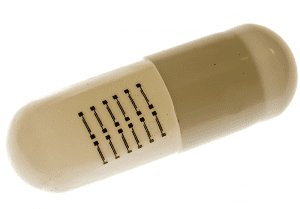The administration of real-time medical diagnostic assays, also known as point-of-care testing, provides patient care in the immediate vicinity of the patient. This technology provides immediate information for medical professionals in clinical decision making, creating a process that is more efficient and cost-effective.
Such real-time assays include the use of edible devices that are ingested by the patient. The device performs the specific test or releases a drug, before transmitting feedback to the clinician. In underdeveloped countries or in natural disaster emergencies, such portable testing would be indispensable. Further edible device technologies could find application in the food industry, similarly to contemporary barcodes where tracking, identification and monitoring are important, but with added functionality.
Semi-invasive technologies for therapeutics and diagnostics have included edible energy harvesters, sensors, and controlled drug release devices, while semi-invasive technologies for food quality monitoring have been realized. The goal of researchers is to provide completely non-invasive technologies for the use in such devices. Ideally, the devices would need to be imperceptible at ingestion, non-toxic, and fully degradable. These solutions would also need to be cost-effective, and scalable for mass production.
Professor Guglielmo Lanzani, Dr Mario Caironi, and their co-workers are one set of such researchers investigating new technologies for edible devices. Dr Caironi states that, ““With our study, we undertake an important first step towards future edible electronics”, which offer “new and exciting inspection tools for active monitoring of patients health from the inside of the body, and for direct tracking of food conservation.”
Bulkiness of current ingestable electronics requires latter evacuation of the device from the body, which limits their application due to a number of factors include patient health.
This work from Professor Lanzani and Dr Caironi highlights the first step towards an edible, biocompatible, degradable electronic device. Their strategy integrates printing of polymer-based circuits with temporary tattoo-paper. The cellulose-based paper is ultrathin and conformable making is suitable for edible technologies.
They demonstrated the printing of organic electronic components with complete transfer onto edible items, without the need for surface modification, which provides a strategy for the production of edible and imperceptible electronics. While much research remains to develop this technology further, the seeds have been sown for a future of non-invasive edible electronics.

















